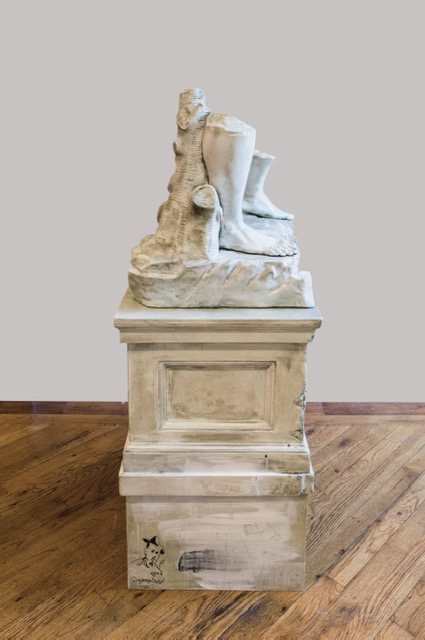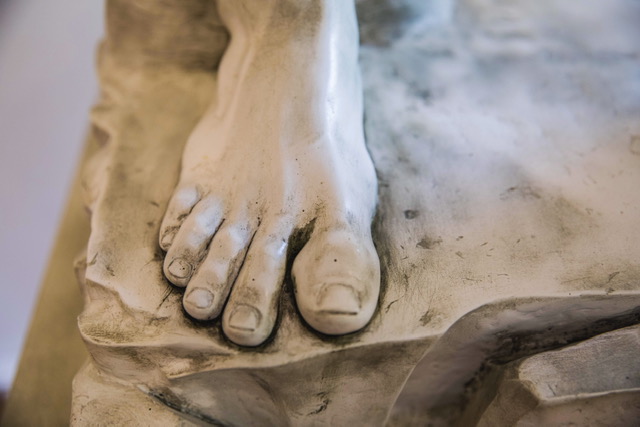
The Sculpture of David was destroyed in the square
Siyuan Tan
Sculpture
23*22*17″
2019
(New York)
My work connects two co-existing spaces. By copying and destroying them, the intersection of human reality, society as well as virtual space, are explored.
Siyuan Tan was born in Fuxin, China, in 1984, and graduated with an MFA in sculpture from the Savannah College of Art and Design, Atlanta, in 2018. Tan’s work not only showcases a skillful artisanship, at the same time, reflects humorous and nearly sarcastic wisdom in his play with sociopolitical and cultural icons and significances from both the East and the West.
Interview of Siyuan Tan
Your work The Sculpture of David Was Destroyed in The Square (2019) resembles a lot to the recent vandalism of confederate statues across America in the wake of Gorge Floyd’s death. What was your original inspiration for creating this piece, and what is your understanding of destruction in arts?
Let’s talk about the initial inspiration for this piece. A while back when I was looking through photos taken during my childhood and family travels, I noticed that in almost every photo of the sculptures in these sites had been vandalized or defaced. There would me messages written on the surface of the sculptures like “so-and-so visited here, so-and-so I love you and so on.” Then I learned from the older generation’s memories and some history books about the destruction of cultural relics during the Cultural Revolution, where people went crazy over ancient sculptures and architectures. During my travels to Europe that I also saw a lot of graffiti and damage flooding the classical sculptures. This act of taking out national consciousness, political ideas, and personal emotions on inanimate materials created an interest in my research. I wondered what it was that made a group of people develop some kind of intense emotions towards simply processed stones, woods, steels, and concretes, to the extent that they have to be removed and overturned. You see some people now in America, Black or white, demanding the removal of confederate statues. As an Asian person and a foreigner, it is really not my place to have an opinion. However, if a part of dark history is being glorified through the medium of sculptures and revokes the pain of the victims, then the sculpture is unquestionably problematic.
Secondly, I would like to talk about my understanding of art being destroyed. I think that any work of art will eventually be destroyed, even if there is no human involvement, the erosion of time will eventually destroy them. The classics that we can still appreciate today carry so much meaning and special emotion that we try our best to preserve them. Though, there can be so many unpredictable variations that any changes can put the work at high risk. At the same time, I also think these works can be resilient if they have already survived hundreds of years.
I understand that you were trained in traditional sculptural practice, what is your understanding of the different styles in sculptures between the West and the East?
Yes, I was trained in very traditional Western classical realist sculpture. However, the interesting thing is that this long training was done in China.
In contemporary understanding, Eastern sculpture is mainly characterized as impressionistic, while Western sculpture is mainly about realism. In the primitive period, however, the characteristics of Eastern and Western sculpture were not very different and there were many similarities. The formal differentiation should have occurred at the end of the Warring States period, the beginning of the Qin Dynasty, while the West should have been at the end of the Classical period, the beginning of the Hellenistic period. (Around 300 B.C.) Of course, the styles of Eastern and Western sculpture were influenced by geography, ethnicity, politics, economics, and warfare. I believe we have to also consider the two civilizations of farming and maritime — the more mature they become, the more prominent they are in their art.
As an Asian artist living and working in America, what is the biggest challenge in your artistic endeavor?
I think the biggest challenge would be to find my self-identity. In fact, the way I was trained as a child to observe, to draw, and to understand art are all based on Western aesthetic standards. It controlled my aesthetics, trapped my way of thinking, and limited my interest in other art forms. This pattern of education led me to focus, even admire solely, the masterpieces of Western art history. My upbringing, however, was entirely in the East, which led to a lack of understanding not only of my own country’s art history, but also of Eastern art as a whole. I had a great deal of distrust and skepticism in my artwork. It was only after I came to the United States that I realized the impact of the long “colonization” of art education on me. I have lost sight of the essence of my own culture and have lost the ability to judge different cultures.
In the last two years, there have been many rebellious and destructive elements in my work, which is my instinct from within and also my subjective will. The intent was not only to have the intention of breaking the long-standing control of basic aesthetic education over my thoughts, but also to re-examine my cultural origins and to seek self-identification. So, you can see in David, I not only wanted to smash the classics of Western culture, which are fed by the capitalist aristocracy, I also used the graffiti to vandalize the surface. I feel as if I were a blue-collar worker, I want to use these cheap, convenient industrial products that are also the source of the blood and sweat that these capitalists are extracting from us, as a weapon to fight back.
We see a trend in the globalization of arts, as a transcultural artist, what could be your biggest concern?
I think every artist has a lot of concerns in this globalizing world, but I think multiple sources of information can be a supply to the creative process. I used to be interested in the changes in international relations, especially the political trends between China and the United States in recent years, as well as network information security, high technology products and so on. Of course, as a minority living in the United States, racism is still the biggest issue.
But after this epidemic, my biggest concern is my health.
During this pandemic, have you been experimenting with new methods in making art? Can you talk about a little bit about your recent paper-based work?
Yes, during this epidemic I experimented with many creative methods. Because of the space limitations, my first phase was mainly acrylic paintings on canvas in small sizes. In the second phase, I switched to paper and started experimenting with watercolor and paper. I’ve also started learning how to make sculptures on the computer and hope to print them out when the epidemic situation gets better.
In addition, the core idea of these recent works on paper is still based on the research direction of “the connection between real space and imaginary space”. My previous thinking in this regard was concretized in the connection between human social life and virtual networks. But the epidemic has forced me to isolate myself, and while living in a limited space, far away from the social world. Connecting to the outside world, an important aspect of my work, has become a luxury. I had to re-examine my relationship with the outside world and where the work was heading next.
I read a number of books on the relationship between inside and outside, on energy transitions, and one of them was on East Asian shamanic culture. It claims that people have an energy called “灵(spirit).” This energy cannot be seen or touched, but it is present in the body. The shaman can perform rituals to cause the “spirit” to be transferred to other living beings to receive warnings and wisdom from nature. And as a Manchu living in Northeast Asia, I saw these shamans at a very young age through their dancing rituals. These new realizations, that are related to my memories and identity, opened up new avenues for my research. Therefore, I began to look for ways to represent the spirits by using colors. At first, I used basic warm and cold contrasts to distinguish between the two energies of real and imaginary. Then I discovered a principle and instrument for thermal imaging, so I started to experiment a lot with these contrasting. Also experimenting complementary warm and cold colors to represent the visual state of the two energies when they meet. In all the images, which are related to life, I cut out specific tissues and organs, except for the eyes. Because the eyes are an important means of psychic energy in shamanic rituals, and also, the eyes are a very significant for East Asians. The special treatment of the eyes is in fact my way of expressing my identity.



